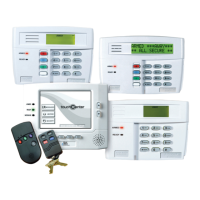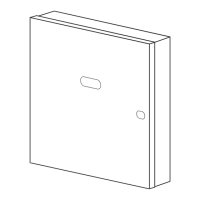–26–
Transmitter Input Types
All of the transmitters described have one or more unique factory assigned
input (loop) ID codes. Each of the inputs requires its own programming zone
(e.g., a 5803's three inputs require three programming zones). See
APPENDIX A toward the end of this manual.
Transmitters can be enrolled as one of the following types:
Type Description
"RF" Sends periodic check-in signals, as well as fault,
(Supervised RF) restore, and low battery signals. The transmitter
must remain within the receiver's range.
"UR" Sends all the signals that the "RF" Type does, but the
(Unsupervised RF) control does not supervise the check-in signals. The
transmitter may therefore be carried off-premises.
"BR" These only send fault signals. They do not send low
(Unsupervised Button battery signals until they are activated. The
RF) transmitter may be carried off-premises.
Transmitter Battery Life
Do not install batteries in wireless transmitters until ready to enroll, as will
be indicated in the procedure that follows under ÒProgramming the Receiver
and Transmitters." After enrolling, batteries need not be removed.
¥ Batteries in the wireless transmitters may last from 4Ð7 years, depending
on the environment, usage, and the specific wireless device being used.
Factors such as humidity, high or low temperatures, as well as large
swings in temperature may all reduce the actual battery life in a given
installation. The wireless system can identify a true low battery situation,
thus allowing the dealer or user of the system time to arrange a change of
battery and maintain protection for that given point within the system.
¥ Some transmitters (e.g., 5802, 5802CP, and 5803) contain long-life but
non-replaceable batteries, and no battery installation is required. At the
end of their life, the complete unit must be replaced (and a new serial
number enrolled by the control).
¥ Button type transmitters (ex. 5801, 5802, 5802CP & 5803) should be
periodically tested for battery life.
¥ The 5802MN and 5804 button transmitters have replaceable batteries.
Using The Transmitter Sniffer Mode
1. Enter Installer code (4112) + # + 3 from partition 1's keypad. This
initiates a procedure that will provide a check that all transmitters have
been properly programmed.
2. The keypad will display all zone numbers of wireless units programmed
into the system. Fault each transmitter in turn, causing each one to send a
signal, rather than let each transmitter send an automatic
supervisory signal.
As the system receives a signal from each of the transmitters, the zone
number of that transmitter will disappear from the display. The
transmitters may be checked upon installation, or in an installed system.
3. When all transmitters have been checked, exit the sniffer mode by keying
Installer code (4112) + OFF.
NOTE: Sniffer mode does not automatically expire. You must manually
exit (installer code + OFF) sniffer mode to return to normal operation.
Sniffer Mode also terminates if a user arms the system.

